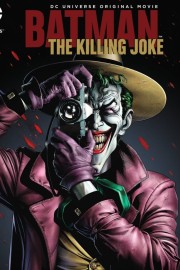Batman: The Killing Joke
Alan Moore’s The Killing Joke, illustrated by Brian Bolland, is one of the boldest and most controversial Batman stories ever told. It’s iconic for pretty much every reason that it’s so controversial, and also because it presents one of the most unforgettable confrontations between Batman and his arch nemesis, the Joker. When I learned that DC was going to adapt it into an animated feature, as they previously had Year One and The Dark Knight Returns, I was excited, but also curious- how faithful were they going to be? Moore’s tale is a brutal one that centers around the paralysis and sexual assault of Barbara Gordon, aka Batgirl? Producer Bruce Timm had some ideas on how that was going to go, though, and how they were going to expand Moore’s brief narrative to feature length. More importantly, though, Timm wanted to bring back Kevin Conroy and Mark Hamill, whose performances as Batman and The Joker, respectively, on “Batman: The Animated Series” were fan favorites. That combination would be a can’t miss proposition, right?
The central thesis of Moore’s story, and the Joker’s devious notion, is that all it takes is one bad day for anyone to become as crazy as he is. His primary goal is to cause Commissioner Gordon to go mad with his kidnapping and humiliation, coupled by the unthinkable attack on his daughter, Barbara (performed by Tara Strong), but he also recognizes that it had to have been as simple as one bad day to turn Batman into who he is, as well. Throughout The Joker’s plan, we get flashbacks on his own origins, as told by Moore, of a failed comedian who is so desperate to provide for his pregnant wife that he turns to a life of crime. One bad day, however, leads to little reason to live, and the crime he takes part in leaves him disfigured when he falls into a vat of chemicals. When Batman arrives on the scene, Gordon is found still lucid, and insistent of bringing The Joker in by the book, so as to show him that true justice works. The complexity of Moore’s storytelling, impressive for how short the story is, makes the tale a powerful read, with Bolland’s illustrations taking things to an expressionistic place few Batman books go. The biggest controversies over the years have come from the recoil people have (understandably) for Barbara Gordon’s fate, which is something Timm and this film’s screenwriter, Brian Azzarello, help soften a bit through a prologue story that focuses on Batgirl as she and Batman take down a criminal with a thing for Batgirl. We see Batgirl as a capable compliment to Batman, as well as a formidable detective in her own right, although her feelings for Batman cloud things for her. That leads to a scene that I can imagine people feeling like a sideways move to improving Batgirl’s storyline in this film, but it leads to an intriguing conclusion to the film’s prologue that ties in nicely to the theme of the story as established by Moore. Exploitative? Perhaps, but an important way in interpreting this story for the big screen. Also helping that is showing us a little tag at the end of Barbara showing she’s not as helpless as The Joker tried to make her.
There’s a lot to like about “The Killing Joke,” as told by Bruce Timm, Brian Azzarello and animation director Sam Liu, with a lot of that goodwill coming from the wonderful voicework by Conroy, Hamill and Strong, the animation style that is quite faithful to Bolland’s original panels, and a musical score by Kristopher Carter, Michael McCuistion and Lolita Ritmanis that gets to the dark heart of the story, and gives Hamill a delightfully malevolent chance to flex his musical chops during a song-and-dance during Gordon’s torture. It lacks the punch and power of Moore’s original book, but it’s another entertaining entry in DC and Warner Bros. Animation’s successful adaptations of classic DC stories, especially from the Dark Knight, in some of his darkest tales of all-time.










